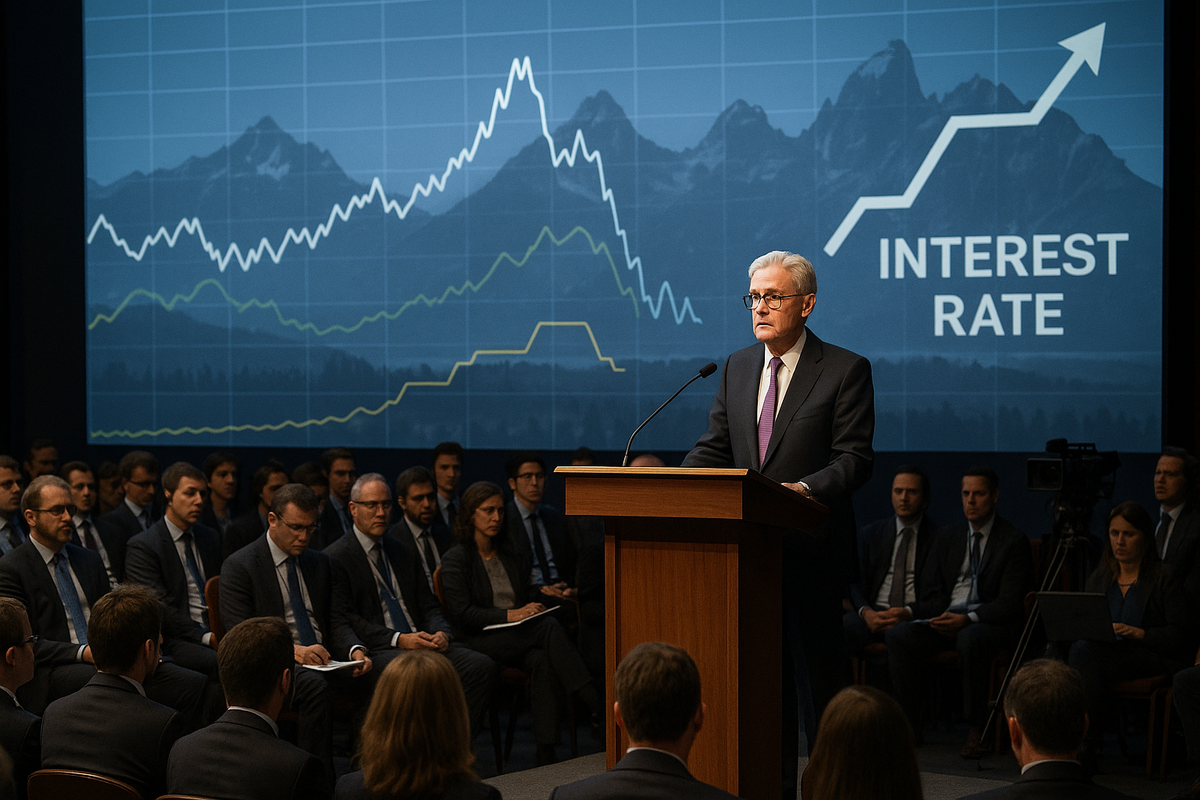
Global financial markets are on tenterhooks, fixated on the highly anticipated speech by Federal Reserve Chair Jerome Powell at the annual Jackson Hole Economic Symposium. Investors are keenly awaiting any signals regarding the future trajectory of U.S. monetary policy, with a significant portion of the market pricing in a potential interest rate cut as early as next month. This fervent expectation stands in stark contrast to the Federal Reserve's recent cautious stance, as revealed in the July meeting minutes, which indicated that most policymakers favored maintaining a steady course. The divergence between market sentiment and the Fed's internal deliberations sets the stage for a pivotal moment that could trigger substantial market reactions and redefine the near-term economic outlook.
The Jackson Hole Conundrum: A High-Stakes Address
The Jackson Hole Economic Symposium, hosted by the Federal Reserve Bank of Kansas City, is an annual gathering of central bankers, finance ministers, academics, and financial market participants from around the world. It serves as a crucial platform for discussing long-term policy issues and, often, for central bank leaders to signal shifts in monetary policy. This year, all eyes are on Jerome Powell's address, scheduled for August 22, 2025, as markets desperately seek clarity on the Fed's next move.
The lead-up to this moment has been characterized by a tug-of-war between evolving economic data and the Fed's stated intentions. For months, the Federal Reserve has maintained its benchmark interest rate within a range of 4.25% to 4.5%, a level held since December 2024. However, recent economic indicators, particularly a softening labor market and moderating inflation trends, have fueled investor optimism for a rate cut. The July jobs report, showing an "anemic growth" of only 73,000 jobs added and downward revisions for previous months, alongside slower-than-expected inflation data, has significantly bolstered the case for easing monetary policy in the eyes of the market. According to CME FedWatch data, the probability of a 25-basis-point reduction in the federal funds rate at the September Federal Open Market Committee (FOMC) meeting currently hovers around 79.1% to 83%.
However, the minutes from the July 29-30, 2025, FOMC meeting, released just days before Powell's speech on August 20, 2025, painted a different picture. These minutes revealed that "almost all" policymakers deemed it "appropriate" to keep interest rates unchanged. The primary concern among members was the potential for tariffs to stoke inflation, outweighing worries about a weakening job market. Despite some moderation, inflation remains "somewhat elevated" and above the Fed's 2% target. This cautious stance, prioritizing inflation control over immediate labor market support, highlights a significant disconnect with market expectations. Two FOMC members, Michelle Bowman and Christopher Waller, notably dissented, advocating for a rate cut, arguing that tariff-induced inflation would likely be a one-time price shift that the Fed should "look through." Powell's speech is therefore critical in bridging this gap, and any deviation from market expectations could lead to significant volatility.
Navigating the Tides: Potential Winners and Losers
The outcome of Jerome Powell's speech at Jackson Hole carries significant implications for various sectors and public companies, creating potential winners and losers depending on whether the Fed signals a dovish (rate cut) or hawkish (steady/higher rates) stance.
If Powell signals a dovish stance, hinting at or explicitly confirming a September rate cut, sectors sensitive to interest rates are poised to benefit significantly. The Real Estate and Homebuilding sectors would likely see a surge, as lower interest rates translate directly into lower mortgage rates, boosting housing demand and making property investments more affordable. Companies like Welltower (NYSE: WELL), a senior housing specialist, would benefit from reduced borrowing costs for new land or facilities, while homebuilders (e.g., those in the S&P Homebuilders Select Industry Index) would experience increased sales. Real Estate Investment Trusts (REITs), which rely heavily on debt financing, could also see improved dividend payouts and reduced costs.
The Consumer Discretionary sector would also likely thrive. With lower debt payments, consumers would have more disposable income, leading to increased spending on non-essential goods and services. Retailers such as Target (NYSE: TGT) and Walmart (NYSE: WMT), particularly those with a significant discretionary goods component, could see a boost in sales.
Utilities companies, often carrying substantial debt, would benefit from reduced interest expenses, leading to higher profitability. As defensive dividend-payers, they become more attractive to income investors when bond yields drop, increasing demand for their stocks. Constellation Energy (NASDAQ: CEG) is an example of a utility that could see improved financial health. Similarly, highly leveraged companies across various sectors, such as AbbVie (NYSE: ABBV) in healthcare and Verizon Communications (NYSE: VZ) in telecom, would see their interest expenses decline, directly improving their bottom lines.
Conversely, a hawkish stance from Powell, indicating a prolonged period of steady or even higher rates, would likely negatively impact these same sectors. Financials, particularly banks, could face challenges. While an initial rate cut can stimulate loan demand, prolonged low rates can compress net interest margins (NIM), the difference between what banks earn on loans and what they pay on deposits, thereby reducing profitability. Banks that rely heavily on this spread could see their earnings squeezed. Companies holding large cash reserves might also see reduced income as yields for cash investments, like Treasuries and money market funds, fall. Furthermore, if a hawkish tone signals a slowing economy, broader market concerns could overshadow any sector-specific benefits.
Industry Impact and Broader Implications
The Federal Reserve's monetary policy decisions, particularly those articulated at high-profile events like Jackson Hole, reverberate throughout the global economy, influencing industry trends, competitive landscapes, and regulatory considerations.
A decision by the Fed to cut rates would signal a shift towards economic easing, primarily aimed at stimulating growth in response to slowing economic activity or deflationary pressures. This would likely lead to increased consumer spending and demand, as lower borrowing costs for mortgages, auto loans, and credit cards free up disposable income. Industries producing durable goods, such as automotive and real estate, would particularly benefit. Manufacturers would see increased cash flow, enabling investments in production, while retailers would benefit from more affordable inventory management. This environment could intensify competition as businesses, with reduced borrowing costs, invest in growth and innovation. Mergers and acquisitions could also see a resurgence as financing conditions loosen.
Conversely, if Powell signals a decision to hold rates steady, it would indicate a "wait-and-see" approach, likely driven by persistent inflation concerns or a desire to assess the impact of previous policy actions. This could lead to moderated economic growth and a cooling labor market. Businesses might adopt a more cautious stance regarding investment and expansion, potentially slowing down activity in some sectors and reducing competitive intensity. Larger, more established firms with stronger balance sheets might be better positioned to weather periods of steady, higher rates compared to smaller businesses that rely more heavily on affordable credit.
Historically, the U.S. has experienced several rate-cutting cycles. For instance, during the 2008 Global Financial Crisis, the Fed aggressively cut rates to near zero, which, after an initial market plummet, contributed to a strong recovery once confidence and liquidity were restored. Similarly, the rate cuts in 2019 and early 2020 in response to trade wars and the COVID-19 pandemic aimed to stimulate the economy. These historical precedents generally show that rate cuts are bullish for stock markets and lead to price appreciation for long-term bonds. However, the current context, with lingering inflation concerns and the unique impact of tariffs, adds a layer of complexity not always present in past cycles. The Fed's July 2025 decision to hold rates steady, despite some dissenting voices, underscores the ongoing debate within the FOMC regarding the balance between its dual mandates of price stability and maximum employment.
What Comes Next
The immediate aftermath of Jerome Powell's speech will undoubtedly be characterized by heightened market volatility as investors digest his words and recalibrate their expectations. In the short term, if Powell signals a September rate cut, we could see a significant rally in equity markets, particularly in rate-sensitive sectors. Bond yields would likely fall, and the U.S. dollar could weaken. Conversely, a hawkish stance, emphasizing inflation concerns and a commitment to higher-for-longer rates, could trigger a market sell-off, with equities declining and bond yields rising.
In the long term, the Fed's actions at Jackson Hole will set the tone for monetary policy for the remainder of the year and potentially into 2026. A sustained period of lower rates, if signaled, could encourage greater corporate investment, potentially leading to increased M&A activity and capital expenditure across industries. Companies might pivot their strategic plans to take advantage of cheaper financing, focusing on expansion, innovation, and debt reduction. This could also lead to a resurgence in initial public offerings (IPOs) as market conditions become more favorable.
However, if the Fed maintains a cautious stance, businesses might need to adapt by focusing on cost efficiencies, strengthening balance sheets, and prioritizing organic growth over debt-fueled expansion. Market opportunities might emerge in defensive sectors or companies with strong cash flows that are less reliant on external financing. Potential scenarios range from a "soft landing" where inflation is tamed without a significant recession, to a more challenging environment if the Fed's actions are perceived as either too slow to address economic weakness or too aggressive in combating inflation, potentially leading to a deeper downturn.
Conclusion
Jerome Powell's address at the Jackson Hole Symposium is more than just a speech; it is a critical juncture for the global financial markets. The stark contrast between market expectations for imminent rate cuts and the Federal Reserve's recent cautious stance creates a high-stakes environment where every word will be scrutinized. The outcome will significantly influence the trajectory of interest rates, impacting everything from corporate borrowing costs and consumer spending to the valuations of public companies and the overall health of the economy.
Investors should closely monitor Powell's language for any subtle shifts in tone or explicit guidance on future monetary policy. Key takeaways will revolve around the Fed's assessment of inflation, the labor market, and the potential impact of tariffs. Moving forward, market participants should watch for subsequent economic data releases, particularly inflation reports and employment figures, as these will continue to shape the Fed's decisions. The coming months will reveal whether the Fed can successfully navigate the complex economic landscape, achieving its dual mandate of price stability and maximum employment, or if the divergence between market expectations and policy realities will lead to further volatility and uncertainty. The lasting impact of this event will be measured by its ability to either instill confidence in a stable economic future or usher in a period of renewed caution and adaptation for businesses and investors alike.






